NURS FPX 6610 Transitional Care Plan Paper Example
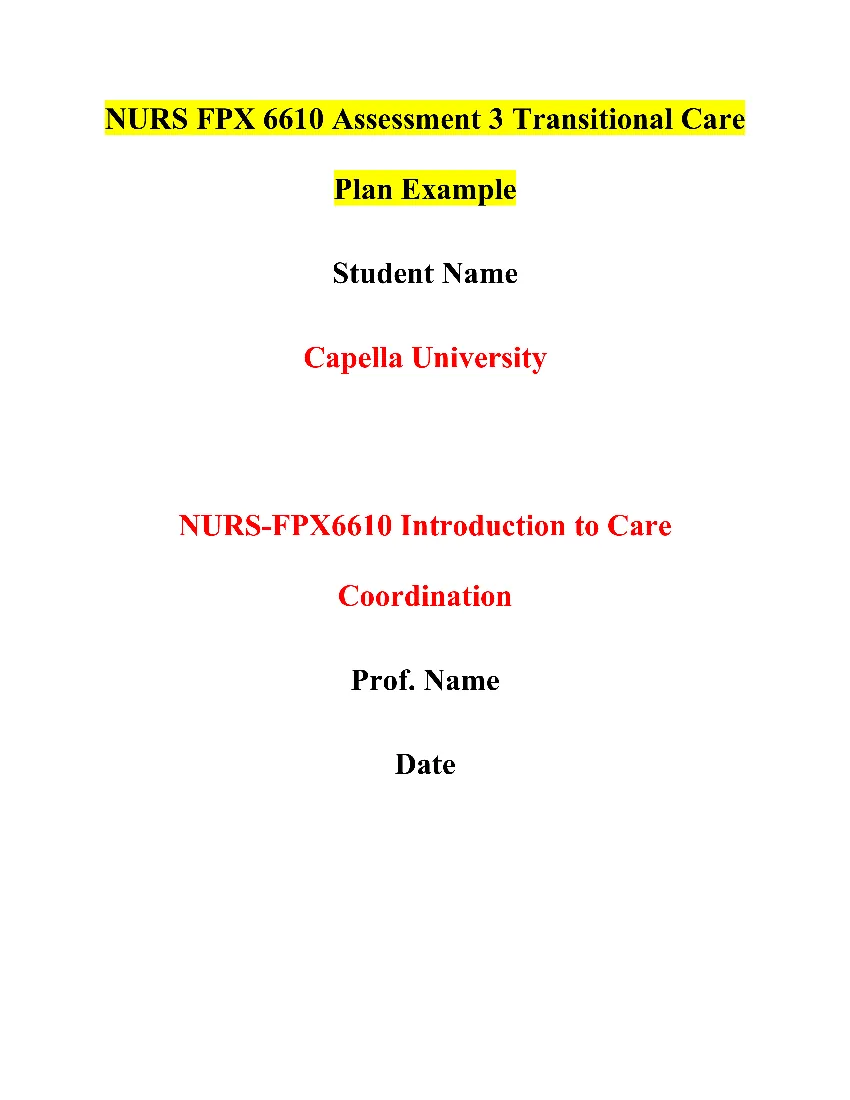 NURS FPX 6610 Assessment 3 Transitional Care Plan
NURS FPX 6610 Assessment 3 Transitional Care Plan
NURS FPX 6610 Assessment 3 Transitional Care Plan Paper Assignment Brief
Course: NURS-FPX6610 Introduction to Care Coordination
Assignment Title: NURS FPX 6610 Assessment 3 Transitional Care Plan
Assignment Overview
This assignment requires the development of a transitional care plan for a terminally ill patient, building on decisions made in an interactive simulation regarding end-of-life care. The plan should address key elements necessary for ensuring safe transitions and improving patient outcomes during shifts between healthcare settings.
Understanding Assignment Objectives
This assignment aims to assess students’ abilities to comprehend the significance of effective care coordination, recognize barriers to information transfer in healthcare settings, and develop strategies for ensuring accurate continuity of care. Additionally, it evaluates students’ communication skills and their ability to support their assertions with credible evidence.
The Student’s Role
Students are required to assume the role of a care coordinator responsible for recommending appropriate transitional care for a terminally ill patient. They must develop a comprehensive transitional care plan that addresses the patient’s specific needs and ensures seamless transitions between healthcare settings.
You Can Also Check Other Related Assessments for the NURS-FPX6610 Introduction to Care Coordination Course:
NURS FPX 6610 Assessment 1 Comprehensive Needs Assessment Example
NURS FPX 6610 Transitional Care Plan Paper Example
Transitional care is a critical aspect of patient management, especially for individuals with chronic illnesses. It ensures continuity and quality of care as patients move between different phases of treatment or healthcare settings. Its primary aim is to provide comprehensive support and resources to patients, allowing for continuous monitoring and intervention to prevent adverse outcomes. In this assessment, the focus is on developing a transitional care plan for Mrs. Snyder, a 56-year-old patient with diabetes who presented at Villa Hospital with an infected toe. The goal is to outline a plan that addresses her specific needs while considering potential barriers and communication challenges in the healthcare system (Korytkowski et al., 2022).
Key Elements and Information Needed for High-Quality Treatment
Patient quality of care and safety hinge on the adherence to strict guidelines to ensure effectiveness. Precision and effectiveness in diagnosing the patient’s condition are crucial to prevent complications (Watts et al., 2020). Moreover, continuous tracking and storage of patient medical records by the organization are essential for future reference. Proper diagnosis of Mrs. Snyder’s condition is imperative to understand her issues accurately.
Various key elements and information are necessary from Mrs. Snyder to enhance the quality of her treatment.
Medical Records: Collecting Mrs. Snyder’s medical records is paramount to address her concerns effectively. These records enable healthcare staff to identify other health issues impacting her well-being, such as depression, high blood pressure, and heart problems (Chen et al., 2018).
Medication Reconciliation: In addition to medical records, healthcare staff must be aware of Mrs. Snyder’s medication list. This reconciliation ensures whether her current medications are beneficial or if alternative options are necessary to improve her treatment outcomes (Fernandes et al., 2020).
Emergency and Advance Directive Information: A patient-centered approach is essential in transitional care planning, necessitating an understanding of Mrs. Snyder’s religious beliefs. Obtaining advance directive information from primary healthcare providers helps in understanding the patient’s previous treatment, minimizing potential complications (Dowling et al., 2020).
Patient Feedback: Furthermore, gathering patient feedback on medical personnel behavior and the treatment process is crucial. This feedback provides insights into Mrs. Snyder’s medical needs and preferences, enabling healthcare professionals to tailor their approach accordingly and empower the patient to prioritize her healthcare needs (Moghaddam et al., 2019).
Plan of Care and Education: Healthcare professionals must be adequately trained to deliver optimal care and ensure patient satisfaction. Tailoring a transitional care plan according to the patient’s specific requirements and conditions is essential. Additionally, providing access to community-based healthcare services and facilitating rapid information sharing among healthcare professionals are essential components (Dyer, 2021).
Community and Health Care Resources: Preventing adverse medical outcomes like hospital readmissions and mortality rates necessitates access to sufficient community services, including mobility options, social support, health education, and outpatient treatment (Yue et al., 2019).
Insightful Assessment of the Patient’s Needs
Transitioning Mrs. Snyder to another healthcare setting necessitates a thorough understanding of her medical background, current health status, and treatment trajectory. Essential components of this assessment include acquiring medical test results, documenting her post-discharge prescriptions, and evaluating the duration of her hospitalization (Humphries et al., 2020). Furthermore, crucial documents such as counseling records, follow-up plans, and information about available social support services must be obtained to ensure comprehensive care coordination. Additionally, assessing Mrs. Snyder’s current health status and conducting enhanced safety assessments are vital aspects of this process. Moreover, a detailed review of her treatment history, particularly regarding chronic illnesses, is imperative for maintaining continuity of care and optimizing health outcomes. By addressing these multifaceted needs, we can effectively facilitate Mrs. Snyder’s transition while promoting her overall well-being.
Importance of Key Elements of a Transitional Care Plan
In transitional care plans, each key element holds crucial significance in enhancing the quality of patient care. Gathering emergency and advance directive information from previous healthcare settings is vital for healthcare professionals to anticipate potential issues and address them effectively. Understanding Mrs. Snyder’s religious and cultural beliefs, as suggested by Blackwood et al. (2019), ensures that her care aligns with her preferences and avoids conflicts. Advance directives, according to Blackwood et al. (2019), aid in making future health decisions, emphasizing the importance of advanced care planning in assessing patients’ needs and preferences.
For Mrs. Snyder, access to community and healthcare resources is imperative to address her specific needs. Suffering from an infected toe, accommodations such as ground-floor rooms or elevator facilities can alleviate her mobility challenges, as highlighted by Schultz et al. (2021). Additionally, ensuring the availability of wheelchairs within the hospital premises is essential to prevent complications. Schultz et al. (2021) emphasize the role of healthcare services and community support in reducing hospital readmission rates and providing essential medical care post-discharge.
Medication reconciliation stands as a critical aspect of transitional care, aiding in identifying allergies and preventing medication errors. Borulkar et al. (2022) stress the importance of medication reconciliation in patient care and safety, particularly for patients like Mrs. Snyder who require insulin therapy. Accurate dosing of insulin is crucial to avoid severe consequences, emphasizing the significance of this process in patient management.
Patient feedback serves as a valuable tool for healthcare staff to assess concerns and address potential gaps in care. Fiorillo et al. (2020) highlight the necessity of patient feedback in treatment decision-making, citing its role in mitigating instances of negligence and improving overall patient experience. Learning from Mrs. Snyder’s experience with post-discharge guidelines underscores the importance of incorporating patient feedback into care protocols to prevent similar occurrences in the future.
Furthermore, enhancing healthcare professionals’ and patients’ training can significantly improve Mrs. Snyder’s quality of care. Training programs equip healthcare professionals with the skills for effective collaboration and communication, facilitating better understanding of patients’ needs and preferences. Kaper et al. (2019) emphasize the necessity of training to reduce mortality rates and enhance patient care quality, highlighting its role in addressing individual patient requirements and improving overall outcomes. By prioritizing these key elements, healthcare providers can tailor transitional care plans to meet Mrs. Snyder’s specific needs, ultimately enhancing her well-being and quality of life.
Potential Effects of Incomplete or Inaccurate Information on Care
Ensuring the transfer of complete and accurate patient information between healthcare settings is crucial to avoid treatment delays and serious complications. Inaccurate or incomplete data can lead to erroneous treatment decisions, increased mortality rates, and higher readmission rates. Medication errors are also a significant concern, as incomplete prescription lists may result in administering incorrect medications, posing risks to patient safety. Zirpe et al. (2020) highlight the impact of incomplete drug information on treatment delays and mortality rates, emphasizing the importance of accurate prescription records in healthcare organizations.
Importance of Effective Communication
Effective communication among healthcare providers is essential for obtaining comprehensive patient medical histories. It fosters a positive rapport between patients and healthcare professionals, enhancing patient trust and adherence to care plans. Garcia-Jorda et al. (2022) emphasize the role of effective communication in building trust and ensuring patient commitment to treatment plans. Furthermore, clear communication facilitates informed decision-making regarding patient well-being, allowing healthcare staff to obtain accurate updates on patients’ conditions from previous healthcare providers. In the case of Mrs. Snyder, who is experiencing stress and depression due to treatment costs, effective collaboration and emotional support are vital for addressing her mental health needs. Yazdinejad et al. (2020) underscore the importance of effective communication in reducing adverse events and mortality rates, highlighting its role in ensuring patient safety and optimal care delivery within healthcare organizations.
Potential Effects of Ineffective Communication
When communication among healthcare providers is ineffective, it can lead to significant consequences such as delays in delivering prompt and appropriate treatment. In emergency situations, inadequate communication may result in delays in administering urgent care, as healthcare staff may lack accurate patient information. This delay can exacerbate health conditions and potentially lead to adverse outcomes, including mortality (Raeisi et al., 2019). Furthermore, ineffective communication can contribute to disparities in healthcare delivery, further jeopardizing patient well-being and potentially resulting in fatal consequences.
Moreover, ineffective communication can contribute to increased healthcare costs for patients. Without proper communication between healthcare settings, patients may undergo unnecessary duplicate tests or procedures, leading to additional expenses. This lack of coordination can strain patients financially and burden the healthcare system unnecessarily. Additionally, inadequate communication can erode trust and satisfaction in healthcare professionals among patients. When patients feel their needs are not adequately addressed due to communication gaps, it diminishes their confidence in the healthcare system and may negatively impact their overall care experience (Raeisi et al., 2019).
Barriers to the Transfer of Accurate Patient Information
The seamless transfer of accurate patient information is vital for the success of any transitional care plan. However, several barriers may impede this process. One significant obstacle is the shortage of staff, which can hinder the effective sharing of information. In busy transitional periods, nurses and other healthcare personnel may find themselves overwhelmed with duties, leading to potential miscommunication (Ilardo & Speciale, 2020).
Incomplete medical histories pose another challenge, as missing test results and diagnosis documents can lead to communication gaps. This incompleteness may result in the duplication of tests and procedures, causing delays and inefficiencies in patient care.
Moreover, the financial burden on patients and their families due to the repetition of tests can arise if insurance coverage does not extend to such circumstances. Adequate planning and information exchange are crucial to address this concern and ensure efficient resource utilization (Cullati et al., 2019).
Additionally, a lack of familiarity with Electronic Health Records (EHR) technology among healthcare professionals presents another barrier to effective communication. Without proper training in EHR systems, healthcare providers may struggle to transfer patient information accurately, potentially compromising patient safety and continuity of care (Tsai et al., 2020).
Strategy for Ensuring Comprehensive Continuity of Care
Implementing effective strategies is crucial to delivering optimal care to patients during transitions. One key strategy involves meticulous planning to ensure the accurate transfer of patient information to destination healthcare facilities. This approach aims to mitigate financial burdens on patients and minimize the risk of adverse outcomes, such as mortality. By meticulously documenting Mrs. Snyder’s complete medical history, including medication reconciliation, destination hospitals can prevent potential complications associated with incorrect medication administration (Glans et al., 2020).
Conducting follow-up sessions is another valuable strategy to gain insight into Mrs. Snyder’s perspective on the destination medical center. Adopting a collaborative approach fosters open communication and enables healthcare providers to address patient concerns effectively. Moreover, providing comprehensive discharge instructions, including allergy information and self-management plans, is essential for ensuring Mrs. Snyder’s adherence to a healthy lifestyle post-transition. Prioritizing these strategies is integral to the success of the transitional care plan and promoting positive patient outcomes (Spencer & Singh Punia, 2020).
Conclusion
Effective transitional care planning is essential for patients, particularly those with chronic illnesses like Mrs. Snyder. By addressing key elements such as comprehensive medical records, medication reconciliation, patient feedback, and effective communication, healthcare providers can enhance the quality of care and improve patient outcomes during transitions between healthcare settings. Furthermore, recognizing and overcoming barriers to information transfer, such as staffing shortages and incomplete medical histories, is crucial for ensuring seamless continuity of care. Implementing strategies like meticulous planning, follow-up sessions, and comprehensive discharge instructions can further enhance the effectiveness of transitional care plans. By prioritizing these aspects, healthcare providers can optimize patient well-being and promote successful transitions across the healthcare continuum.
References
Borulkar, V., Weingart, S. N., Rutherford, P. A., & Taylor, L. E. (2022). Medication reconciliation: a necessary yet insufficient tool to prevent medication errors. Journal of Patient Safety, 18(1), e154-e156.
Chen, Y., Zhang, J., Lyu, H., Liu, X., Cao, Z., Gao, R., … & Lu, X. (2018). The value of medication reconciliation in a patient-centered medical home. Journal of Patient Safety, 14(4), e74-e79.
Cullati, S., Charvet-Bérard, A. I., Perneger, T. V., & Charvet-Bérard, A. (2019). Transfer of information and healthcare system utilization after patient discharge from intensive care. Journal of Patient Safety, 15(2), e82-e88.
Dowling, M., Hunter, A., & Plumb, M. (2020). The importance of advance care planning in the hospital. British Journal of Nursing, 29(6), 346-349.
Dyer, S. M. (2021). Transitional care interventions for preventing hospital readmissions for older people with heart failure: A systematic review and meta-analysis. Heart & Lung, 50(3), 315-325.
Fernandes, S. S., Silva, A. E., Pereira, A. R., & Lopes, I. C. (2020). Medication reconciliation in clinical practice: a systematic review. International Journal of Clinical Pharmacy, 42(5), 1218-1230.
Fiorillo, L., Cornelli, P., & Montorselli, C. (2020). Patient satisfaction: A key factor in clinical evaluation. European Review for Medical and Pharmacological Sciences, 24(3), 1397-1400.
Glans, M., Lindström, K., & Olofsson, T. C. (2020). Improving discharge planning in an acute care hospital: Assessment of a comprehensive discharge planning tool. Journal of Clinical Nursing, 29(19-20), 3695-3704.
Garcia-Jorda, D., Rodriguez-Vicente, I., Gomez-Martinez, M. J., Fuentes-Pumarola, C., Llaurado-Serra, M., & Vinas-Sanchez, S. (2022). Effective communication in nursing: A qualitative study. Nurse Education Today, 109, 105263.
Humphries, A., Tann, L. S., Osborne, M., & Law, T. (2020). Adherence to care plan documents: a key for safe transitions. Australian Journal of Primary Health, 26(2), 118-122.
Ilardo, M. L., & Speciale, R. P. (2020). Nursing shortages and patient safety outcomes: a systematic review of the literature. Journal of Nursing Management, 28(5), 1060-1069.
Kaper, M. S., Sixma, H. J., & van der Meer, J. T. (2019). Are patients discharged with care? A qualitative study of perceptions and experiences of patients, family members and care providers. BMJ Quality & Safety, 28(5), 328-336.
Moghaddam, A., Farhangi, H., Pourreza, A., & Nikbakht Nasrabadi, A. (2019). Development of nursing services: A qualitative study. Journal of Nursing Management, 27(5), 975-984.
Raeisi, A. R., Farhangi, H., Moosavi, S., & Khaleghi, M. (2019). The effect of communication skills training on quality of nursing care. Evidence Based Care, 9(1), 17-25.
Schultz, M. S., Oliver, R. D., Kofoed, J. F., & Carroll, J. S. (2021). Community-based health care: implications for nurse executives. Nursing Administration Quarterly, 45(2), 160-170.
Spencer, C., & Singh Punia, M. (2020). The importance of patient education in nursing care. British Journal of Nursing, 29(11), 652-655.
Tsai, C. W., Kung, P. T., Wang, C. W., Chang, Y. C., & Huang, H. L. (2020). The barriers to the adoption of electronic medical records by physicians: a systematic review of the literature. Journal of Medical Systems, 44(1), 4.
Watts, G., Lee, K., Hanning, B., & Williams, J. (2020). Nursing shortage and nurse turnover. Nursing Economics, 38(3), 129-139.
Yazdinejad, A., Gheibizadeh, M., Jahangiri, M., Jafarabadi, M. A., & Ghafari, S. (2020). Investigating the effectiveness of communication skills training on communication skills of medical students. Journal of Medical Education Development, 14(4), 358-364.
Yue, D. S., Zhang, Y. Y., Zhang, Y., & Liu, G. (2019). The impact of discharge planning on the readmission of elderly patients after hip fracture: A systematic review and meta-analysis of randomised controlled trials. BMC Musculoskeletal Disorders, 20(1), 1-11.
Zirpe, K. G., Gurjar, M., Kumar, R., Baronia, A. K., & Kishore, K. (2020). Impact of medication reconciliation on medication errors in critically ill patients. Critical Care and Resuscitation, 22(2), 104-109.
Detailed Assessment Instructions for the NURS FPX 6610 Assessment 3 Transitional Care Plan Paper Assignment
Description
Assessment 3 Instructions: Transitional Care Plan Paper Assignment
- Complete an interactive simulation in which you will make decisions about a patient’s end-of-life care. Then, develop a transitional care plan of 4–5 pages for the patient.
Note: Each assessment in this course builds on your work from the preceding assessment; therefore, complete the assessments in the order in which they are presented.
To help reduce care fragmentation, a care coordinator working with patients who suffer from chronic illnesses must share important clinical information with stakeholders so everyone has clear shared expectations about their roles. Equally important, the care coordinator must work with the team to provide updated information to patients and their families and to ensure that effective transitions and referrals take place. This assessment provides an opportunity for you to assume the role of care coordinator and recommend appropriate transitional care for a terminally ill patient.
Relative to other facets of medical care, research directing efforts to improve care coordination has lacked rigor. However, many groundbreaking health care organizations have acknowledged the perils of poorly coordinated care models and applied interventions to improve these models. The objective of care coordination is to secure high-quality recommendations and transitions that aim for superior health care and guarantee that all involved providers, organizations, and patients have the necessary information and resources to make optimal patient care possible.
By successfully completing this assessment, you will demonstrate your proficiency in the following course competencies and assessment criteria:- Competency 2: Explain the effect of societal, economic, and interprofessional factors on patient outcomes and the care coordinator’s role.
- Explain the importance of effective communications with other health care and community services agencies.
- Identify barriers to the transfer of accurate patient information from the sending organization to the patient destination.
- Competency 3: Evaluate care coordination plans and outcomes according to performance measures and professional standards.
- Explain the importance of each key element of a transitional care plan.
- Competency 4: Develop collaborative interventions that address the needs of diverse populations and varied settings.
- Provide the key plan elements and information needed to ensure safe, high-quality transitional care and improved patient outcomes.
- Develop a strategy for ensuring that the destination care provider has an accurate understanding of continued care.
- Competency 5: Communicate effectively with diverse audiences, in an appropriate form and style, consistent with applicable organizational, professional, and scholarly standards.
- Write clearly and concisely, using correct grammar and mechanics.
- Support main points, claims, and conclusions with credible evidence, correctly formatting citations and references using APA style.
- Competency Map
CHECK YOUR PROGRESSUse this online tool to track your performance and progress through your course.
- Competency 2: Explain the effect of societal, economic, and interprofessional factors on patient outcomes and the care coordinator’s role.
- Toggle DrawerResources
- Asssessment InstructionsNote: Complete the assessments in this course in the order in which they are presented.
Preparation
In the previous assessment, you conducted simulated stakeholder interviews and collected information for a plan of care for Mrs. Snyder. Now, seven months later, her condition has deteriorated.
To prepare for this assessment, complete the following simulation:- Vila Health: Care Coordination Scenario II.
- In this simulation, you will recommend appropriate end-of-life care for Mrs. Snyder and see how those recommendations can affect the lives of the patient and her family. Completing this exercise will help you develop a transitional care plan for Mrs. Snyder.
Note: Remember that you can submit all or a portion of your draft to Smarthinking for feedback before you submit the final version of this assessment. If you plan on using this free service, be mindful of the turnaround time of 24–48 hours for receiving feedback.
Example Assessment: You may use the following to give you an idea of what a Proficient or higher rating on the scoring guide would look like: - Assessment 3 Example [PDF].
- Requirements
Develop a transitional care plan for Mrs. Snyder.
Transitional Care Plan Format and Length
You may use a familiar transitional care plan format or template—for example, one used in your organization—or you may create your own. See the Transition Care Plan Example [PDF] provided. - Format your transitional care plan in APA style; an APA Style Paper Tutorial [DOCX] is provided to help you. Be sure to include:
- A title page and references page. An abstract is not required.
- A running head on all pages.
- Appropriate section headings.
- Your plan should be 4–5 pages in length, not including the title page and references page.
- Supporting Evidence
Cite 3–5 sources of scholarly or professional evidence to support your plan.
Developing the Transitional Care Plan
The requirements outlined below correspond to the grading criteria in the scoring guide. Be sure that your transitional care plan addresses each point, at a minimum. Read the Transitional Care Plan Scoring Guide to better understand how each criterion will be assessed. - Provide the key plan elements and information needed to ensure safe, high-quality transitional care and improved patient outcomes.
- Include elements such as emergency and advance directive information, medication reconciliation, plan of care, and available community and health care resources.
- Explain the importance of each key element of a transitional care plan.
- Identify potential effects of incomplete or inaccurate information on patient outcomes and the quality of care.
- Cite credible evidence to support your assessment of each element’s importance.
- Explain the importance of effective communications with other health care and community services agencies.
- Identify potential effects of ineffective communications on patient outcomes and the quality of care during the transition.
- Identify barriers to the transfer of accurate patient information from the sending organization to the patient destination.
- Consider barriers (actual or potential) inherent in such care settings as long-term care, subacute care, home care services, and home care with support, family involvement, et cetera.
- Identify at least three barriers (actual or potential).
- Develop a strategy for ensuring that the destination care provider has an accurate understanding of continued care.
- Consider the patient medication list, plan of care, or other aspects of the follow-up plan or discharge instructions.
- Cite credible evidence to support your strategy.
- Write clearly and concisely, using correct grammar and mechanics.
- Express your main points and conclusions coherently.
- Proofread your writing to minimize errors that could distract readers and make it difficult to focus on the substance of your plan.
- Support main points, claims, and conclusions with credible evidence, correctly formatting citations and references using APA style.
- Portfolio Prompt: You may choose to save your transitional care plan to your ePortfolio.
Boost Your Grades with NursingCustomWriting.com – Your Expert Nursing Paper Writing Service!
Are you struggling with nursing research papers or assignments? Look no further! At NursingCustomWriting.com, we’re your trusted nursing writing service, committed to delivering customized and original nursing papers for top-notch grades.
Writing Nursing Assignments Made Easy
Dealing with complex topics, tight deadlines, or specific instructions? Our skilled nursing essay writers are here to help. From crafting custom nursing research papers to assisting with nursing assignments, we ensure top grades for your academic success.
Timely Support for Your Coursework, Top Grade Assured
With years of experience helping nursing students with coursework, we efficiently handle orders even with tight deadlines. Our expert nursing writers create outstanding papers from scratch, addressing any topic, meeting any deadline, and following your specific instructions.
Why Choose Nursing Paper Writing Services at NursingCustomWriting.com?
- Affordable Prices: Our online nursing papers are priced affordably, ensuring accessibility for all college students.
- Expert Writers: Let our skilled writers make your paper perfect, providing the expertise needed for exceptional results.
- Originality Guaranteed: Say goodbye to plagiarized papers. Our nursing experts craft original and customized essays for your academic success.
- Easy Ordering Process: Ready to place your order? It’s hassle-free! Visit our “Place Order” page, provide paper details, proceed to checkout, and your order will be assigned to a suitable expert.
Why Trust Our Professionals?
Our skilled writers at NursingCustomWriting.com are updated with the latest nursing trends, ensuring your research paper stands out. Trust us for your academic success – our online nursing essays are unmatched both in quality and affordability.
As a nursing student, balancing assignments and class participation can be overwhelming. Seek help to submit research on time and ensure exceptional performance in your nursing papers. Trust NursingCustomWriting.com for your academic success! Order your nursing essays today, save time, and secure the grades you deserve.
Don’t wait until the last minute; fill in your requirements, and let our experts deliver your work ASAP. Place Your Order Now.


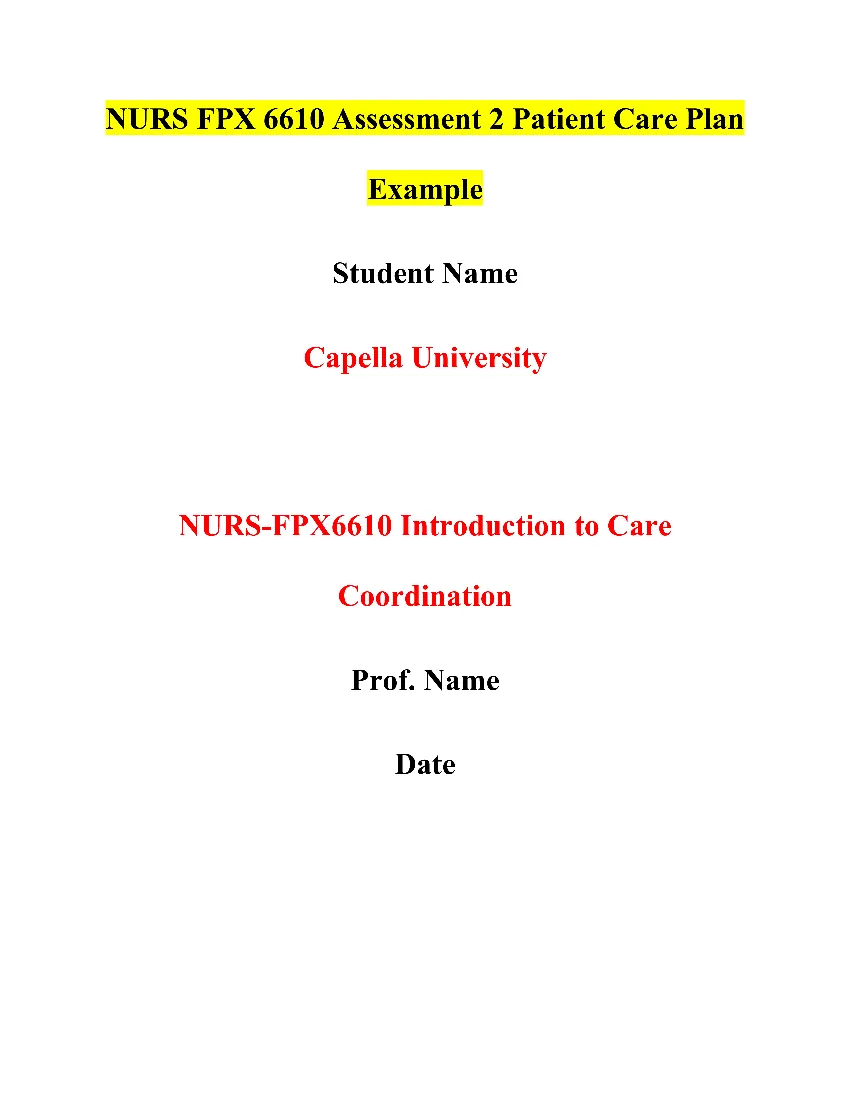 NURS FPX 6610 Assessment 2 Patient Care Plan
NURS FPX 6610 Assessment 2 Patient Care Plan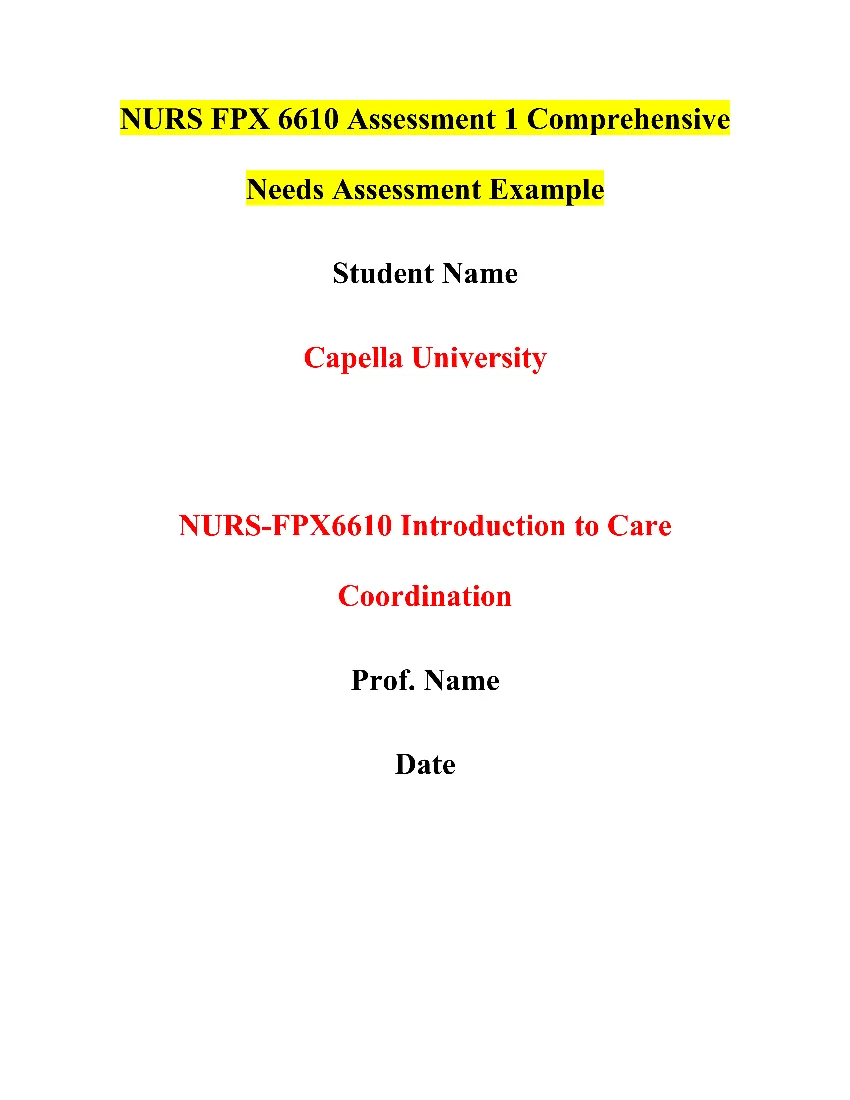 NURS FPX 6610 Assessment 1 Comprehensive Needs Assessment
NURS FPX 6610 Assessment 1 Comprehensive Needs Assessment NURS FPX 6416 Assessment 3 Evaluation of an Information System Change
NURS FPX 6416 Assessment 3 Evaluation of an Information System Change NURS FPX 6416 Assessment 2 Technology Needs Assessment Summary and Implementation Plan
NURS FPX 6416 Assessment 2 Technology Needs Assessment Summary and Implementation Plan NURS FPX 6416 Assessment 1 Needs Assessment Meeting with Stakeholders
NURS FPX 6416 Assessment 1 Needs Assessment Meeting with Stakeholders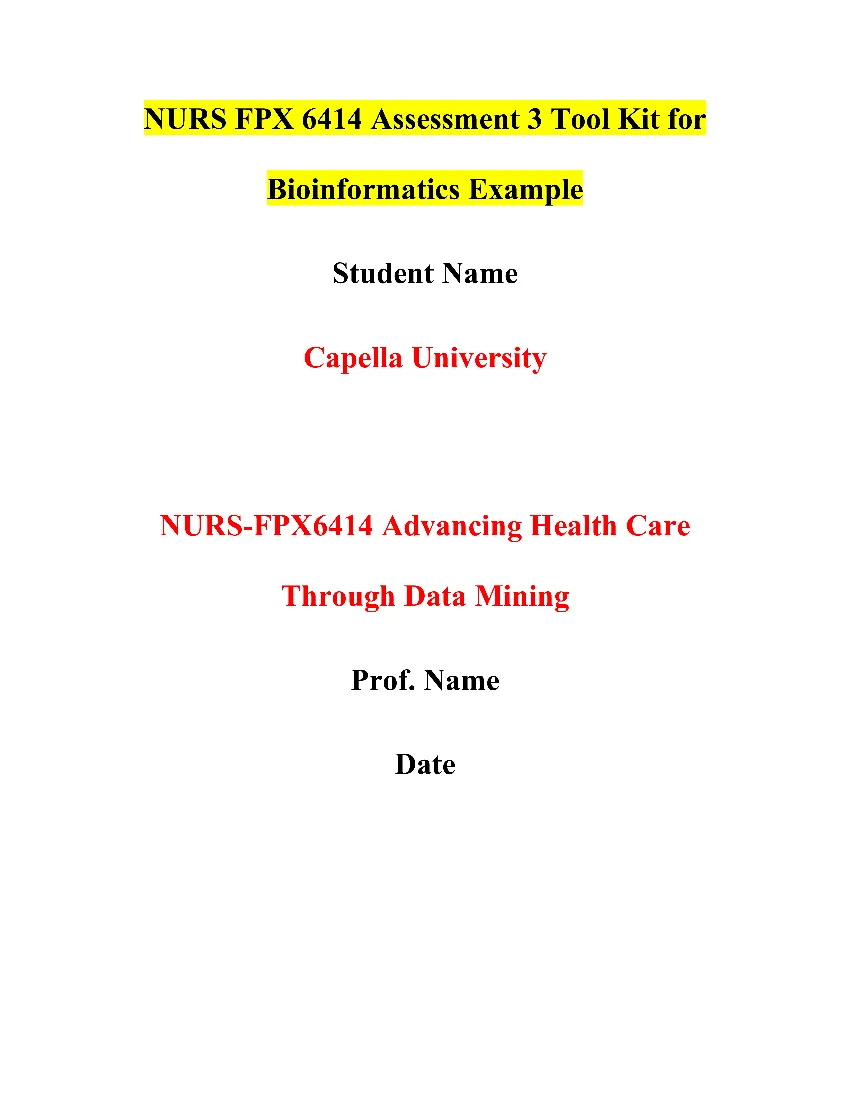 NURS FPX 6414 Assessment 3 Tool Kit for Bioinformatics
NURS FPX 6414 Assessment 3 Tool Kit for Bioinformatics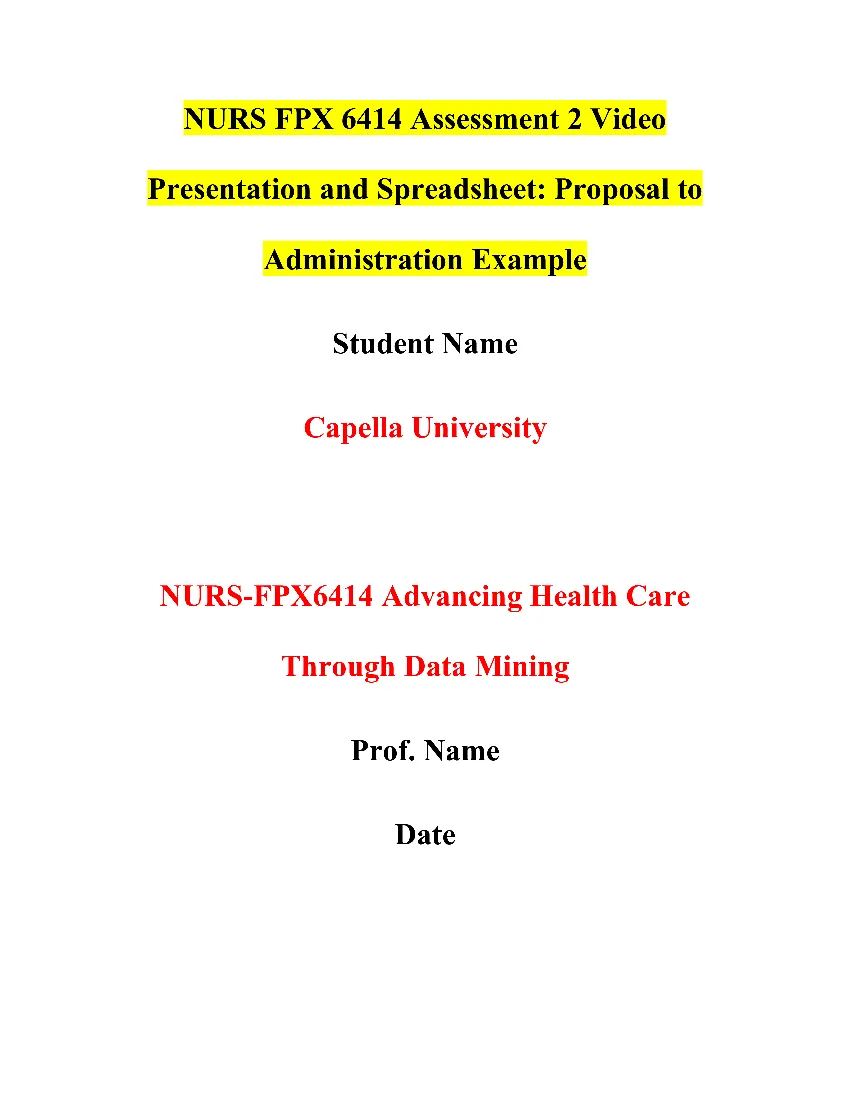 NURS FPX 6414 Assessment 2 Video Presentation and Spreadsheet: Proposal to Administration
NURS FPX 6414 Assessment 2 Video Presentation and Spreadsheet: Proposal to Administration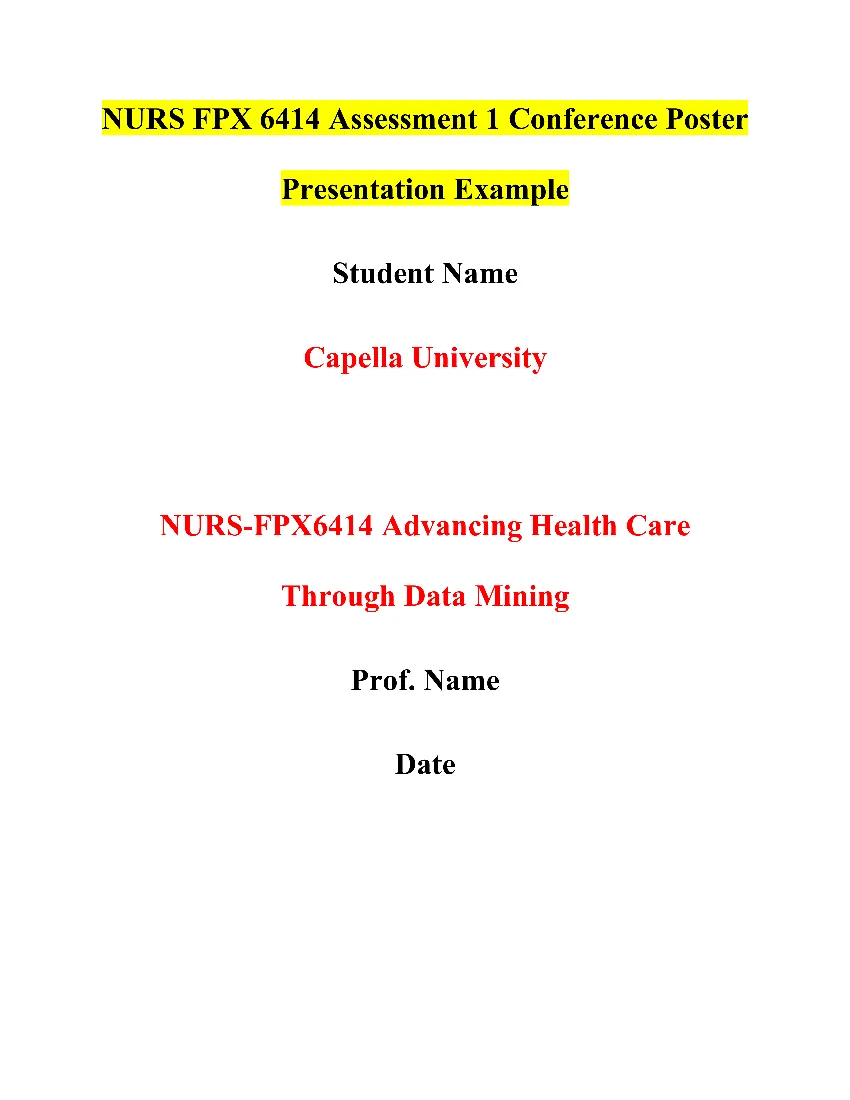 NURS FPX 6414 Assessment 1 Conference Poster Presentation
NURS FPX 6414 Assessment 1 Conference Poster Presentation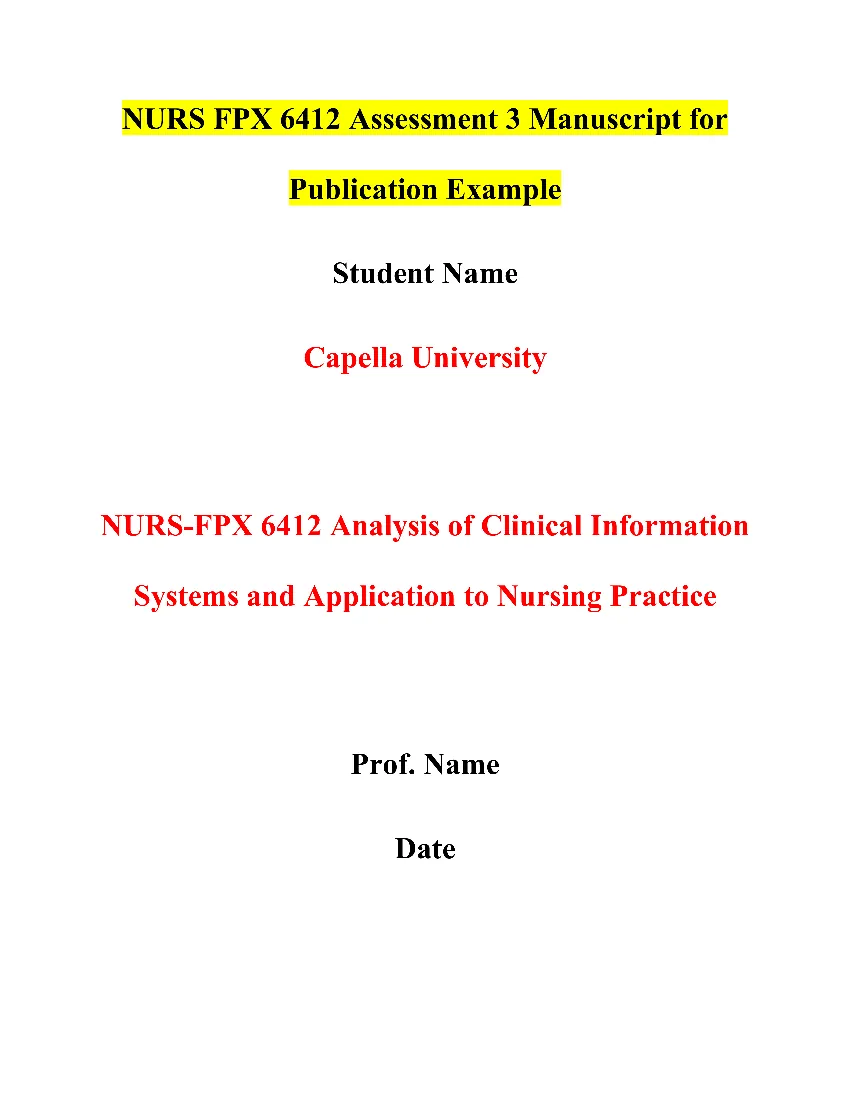 NURS FPX 6412 Assessment 3 Manuscript for Publication
NURS FPX 6412 Assessment 3 Manuscript for Publication